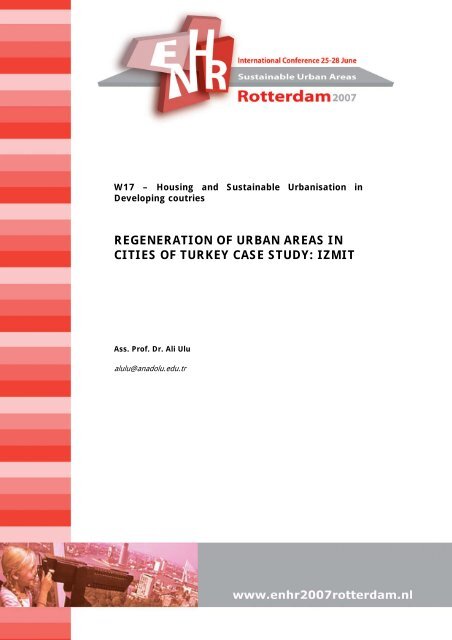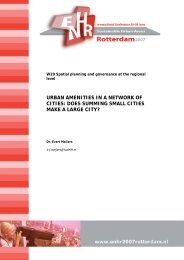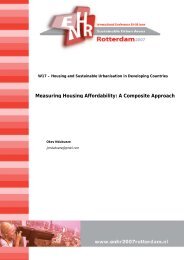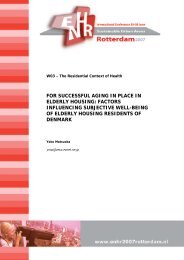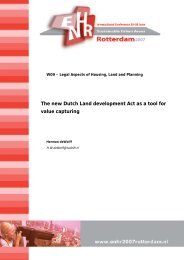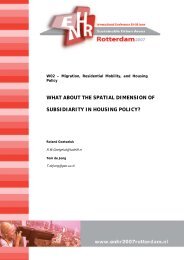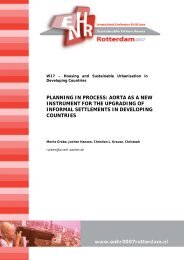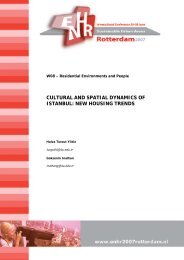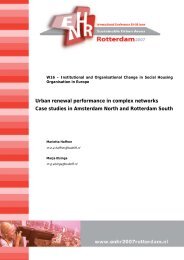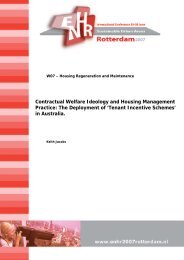Download - ENHR 2007 Rotterdam
Download - ENHR 2007 Rotterdam
Download - ENHR 2007 Rotterdam
You also want an ePaper? Increase the reach of your titles
YUMPU automatically turns print PDFs into web optimized ePapers that Google loves.
W17 – Housing and Sustainable Urbanisation inDeveloping coutriesREGENERATION OF URBAN AREAS INCITIES OF TURKEY CASE STUDY: IZMITAss. Prof. Dr. Ali Ulualulu@anadolu.edu.tr
REGENERATION OF URBAN AREAS IN CITIES OF TURKEYCASE STUDY: IZMITAss. Prof. Dr. Ali ULUAnadolu University, Faculty of Engineering and Architecture,Department of Architecture, Eskisehir, Turkey e-mail: alulu@anadolu.edu.trtel: 00- 90-222 321 35 50/ 6672AbstractIn 2005, the act was published “transformation of urban areas” for the reproduction of urbanareas where and how to plan and construct new housing for the 21st century in Turkey. The actset out the changes needed to the planning system and building regulations to regeneratesustainable urban plots into the housing areas. Since then, there have been major changes to theplanning and housing production system. The forthcoming implimentation for Sustainablesquatter and illegal hosing areas may also play an important part in raising environmentalstandards. Urban regeneration in housing areas seeks to transform to squatter and illegal housingat regional and local levels that need sustainable design and construction. Regeneration of urbansquatter or illegal established housing areas has been the central element of urban discussions inTurkey since the 1950s, with different approaches from clearance to upgrading with the aim ofdecreasing the negative effects of these areas in the urbanization process of Turkish cities untilthe 1980s. Following the 1980s however squatter housing areas, especially the ones located ininner-city areas have become the focus of attention with an increasing element of devaluation ofthe land market within the sphere of neo-liberal urban policies of the governments under theeffect of the new global economy. Municipalities which have squatter or illegal establishedhousing areas within their boundaries, use urban transformation and regeneration projects toimprove their living conditions and physical built environment with the standards of acontemporary life style while transforming these areas into prestige zones of their governmentalsuccess also by using the great economic potentials of centrality on space. Thus, while usingcommunity-based approaches to local regeneration to promote social inclusion, municipalitiesfind themselves in a global environment of the market economy with an unprecedented amountof capital flow into these areas both from the governments with new public programs and fromthe professional developers discovering the great potential of rent that is identified with the1
location. In this paper, first the reasons of social and physical affections will be discussed in acomparative analysis of four urban transformation projects implemented in Izmit, industrial cityin Marmara Region of Turkey, based on the results of an area research. Secondly, the communitycomponent in project formations will be discussed with the help of questionnaire results trying todepict the percentage and way of community involvement in local regeneration. The aim of thisresearch is to find out the net effect of community involvement in social inclusion within thesphere of local regeneration projects and/or policies with a critical approach of discussion onproject formulations under the pressures of market economy.1. Regeneration of illegal and squatter housing areas In TurkeyThe main idea of regeneration has been the maintenance and improvement of the economicstrength of cities to be critical to the competitive performance of the country as a whole. In factthe physical, economic and social decline of inner city areas over the past three decades hasresulted in growing pressure for more effective urban regeneration (Adair, 2000). In Turkey sincethe 1950s, regeneration of illegal and squatter housing areas have been the central element ofurban problem, with different approaches from clearance to upgrading with the aim of decreasingthe negative effects of these areas in the urbanization process. Following the 1980s however,illegal and squatter housing areas, especially the ones located in inner-city areas have become thefocus of attention with an increasing element of devaluation of the land market in urban spaces.(Ulu, 2003) Once considered to be the physical expression of a socio-economic problem and sotried to be solved with either radical or populist approaches facing with the ineffiencies of theeconomy, illegal and squatter housing areas are now the preliminary concern of themunicipalities to take the advantage of the devaluated market there. So, urban regeneration hasrecently been a central issue of consideration, and attempts to regulate this process havemultiplied in Turkey. There is regulation to regenerate of illegal and squatter housing areas inlegal framework.According to The Law of Municipalities (5215; 2004), Municipalities are responsible forprotecting natural, historical and cultural assets in their functions of plan preparation. Theintended Law empowers the municipalities in the designation of several types of special planningareas for the purposes of implementing projects concerning protection, regeneration, intensivedevelopment, and public and/or private investments. Municipalities are obliged to carry out2
mitigation plans to reduce disaster risks, if ignored; the Ministry could use its prerogatives. Theyare entitled to determine the location and size of areas for such operations, prepare plans andprojects. The municipality or the majority of the property owners in an area could formpartnerships for the redevelopment and/or joint management of the area. Besides physicaloperations of clearance, development, protection, such projects are envisaged to cover policies offinance, management, ownership and means of socio-economic development.The illegal and squatter housing problem in Turkey appeared as a result of unprecedenteddimensions of rural-urban migration during the 1940s in Turkey. Massive migration of peoplefrom rural areas to major urban centers has characterized the process of urbanization in Turkey.The consequence of this process have ranged from problems of un-unemployment to thedeterioration of the strained urban services as well as formation and continuous expansion oflarge squatter areas within and around the major urban centers of the country. Its level is highenough to justify a qualification of process of urbanization in Turkey as being unhealthy. Urbanservices are strained to the point that a major hazardous break is not improbable.Between beginning to 1960’s to 2004, the governments, politicians, municipalities and theindustrialists had encouraged migration without thinking of its effects on urban space, becausemigrated population offered them cheap labor force, they could not provide housing in face of theineffectiveness of the ways of legal housing provision in Turkey. Within this period politicalapproaches in favor of populism especially in the share of urban rent, have given this populationpower in the urban land market (Tekeli,2000) and illegal and squatter housing population gaineda new status with the power of speculation. So, illegal and squatter housing areas especially ininner-city areas became problem area to integrate urban areas for the future.The first legislative implimentation to solve the illegal and squatter housing areas problems forintegration of urban spaces is the forgiveness of construction. (Şanlı, 1976) This governmentconcession caused to rebuild the illegal and squatter houses from 1-2 stores to 4 stores apartmentblocks. But, while rebuilding in areas located in inner-city areas, transformation cannot beachieved in illegal and squatter areas. This attitude continued until the governments developednew legislation for regulation to of urban transformation in 2004. The special Laws (The Law of‘Greater city Municipalities’:5216; 2004, The Law of Municipalities:5215, section 73,; 2004, TheLaw Concerning the Northern Entry to Ankara: 5104; 2004, the Compulsory Purchase Law:3
2942) are legislated to increase of improving the appearances and “life standards” of illegal andsquatter housing areas. The Greater Municipalities in Turkey are responsible for the preparationof a plan (1/5000), subject to the approval of the Ministry. All public and private property issubject to compulsory purchase. This is preferably carried out with mutual agreements betweenproperty owners and the Municipality. An inventory of property owners entitled to specific sharesin prospective property is to record the size, development type, and the legal status of currentproperty. This provides options for individuals (tenants included), and describes a program ofpayments, the value of the existing property deduced from total debt.The non-conforming property owners are subject to the special procedures of the CompulsoryPurchase Law (2942), empowering the municipality to distribute payments up to 5 years. TheGreater Municipalities have access to credits of the Housing Administration for theirimplementing projects. The intended Law empowers the municipalities in the designation ofseveral types of special planning areas for the purposes of implementing projects concerningprotection, regeneration, intensive development, and public and/or private investments.Municipalities are obliged to carry out mitigation plans to reduce disaster risks, if ignored, theMinistry could use its prerogatives. They are entitled to determine the location and size of areasfor such operations, prepare plans and projects.The municipality or the majority of the property owners in an area could form partnerships forthe redevelopment and/or joint management of the area. Besides physical operations of clearance,development, protection, such projects are envisaged to cover policies of finance, management,ownership and means of socio-economic development. (Thorns, 2004) Protecting the rights ofthe original owners, the municipalities in these areas could carry out lease agreements, servitudes,comprehensive project development, tendering for construction, supervision, arranging sharesaccording to the Flat Ownership Law, management organizations, etc.... and demolish existingbuildings avoiding public purchase, Such property will be exempt from sales and purchase taxesfor 20 years by using of credits.2. Urban Regeneration project in İzmit Erenler- Cedit; illegal and squatter housingarea:İzmit Erenler- Cedit illegal and squater housing area, located at the north of Izmit, has a numberof major potential sites and development prospects at the metropolitan scale. These will have4
direct impact on the regeneration of the district, and plans will have to base their strategies ontheir shaping. Large tracks of land available at two distinct points in the area constitute a rareopportunity at the metropolitan level. The fate of these areas is not unpredictable as manydecisions are already made. However the sheer size of these investments demands carefulplanning and procurement, involvement of investors from abroad, and competitive mechanismsin their design and development.The purpose of this project is to demonstrate that comprehensive regeneration could prove viablein physical, economic and social terms, even under most adverse conditions. İzmit Erenler- Ceditillegal and squatter housing area has comparative advantages in comprehensive regenerationwithin the metropolitan context. Unique local opportunities exist to capitalize and generate animpetus for total physical change and robust development.5
Strategic Plan (scale: 1/5000) and İzmit Erenler- Cedit Regeneration Implimentation Plan (Great Municipalityof Kocaeli (İzmit) Council in 15.09.2005/1091).The dominant form of development in İzmit Erenler- Cedit illegal and squatter housing area isunauthorized blocks of flats on informally subdivided land. Although all technical andengineering services were avoided at their inception, a minor part of this stock experienced legalregistration after 1984. This does not however make them any safer. The urban texturecharacteristics are narrow and irregular roads, complete coverage in plots, small frontage, 1-5storey high blocks with high proportion of circulation spaces in the buildings. This represents notonly a waste of space, but also a large pool of risks. When EQ strikes, risks are consistently veryhigh irrespective of whether one is within the buildings or out in the street. This is thefundamental reason for a comprehensive regeneration, rather than a retrofitting policy confined tosingular buildings. Retrofitting of the unauthorized stock is legally and socially not viable.Another reason for comprehensive regeneration is the intense need for social and economicpromotion of households, and the enhancement of community life, collective activities andspaces. It is essential to improve life standards, introduce variety in economic sectors andemployment, and induce social integration in İzmit Erenler- Cedit illegal and squatter housingarea, besides physical redevelopment. A comprehensive regeneration approach will not onlydiscard the idea of piecemeal retrofitting operations but also invalidate partial attempts aswidening of ‘evacuation boulevards’. The neighborhood living on İzmit Erenler- Cedit illegal and6
squater housing area of problem, as same as other squatter areas, is unhealthy life conditions inadequate of urban functions in the houses.This project is started to implimentation after getting approval Great Municipality of Kocaeli(İzmit) Council in 15.09.2005. This project area included in existing of 28.226-m2-constructionarea, 142 houses, 269 plots and 136.250 m 2 plot area. In projected area, 32 blocks consisting of117.814m 2 construction area, 972 houses on 87.255m 2 plot area are planned to regeneration ofİzmit Erenler- Cedit illegal and squatter housing area.The population of regeneration area has been changed the pattern of ownership, originalpopulation with newcomers. The project area has not been transformed sharply since it has beenstarted. 80 % of the survey population said that they would sell their houses lots in the futurebecause of new housing prices. There appears two levels of displacement. In prestigiouslocations, inner-city squatter housing areas replaced with upper-income neighborhoods, privatedevelopers expect high profit returns thus implementation of a public-private participation modelis easier. New houses’ profit shows itself with an increasing element of prestige and luxury onurban space. At the other end of the spectrum it is an upper income population who seeks for andcan afford this luxury and prestige on space. Thus regeneration is unavoidable in the short-run forİzmit Erenler- Cedit illegal and squatter housing area. On the other hand although the level ofdisplacement increases, its speed decreases respective of life preferences and/or life satisfactioncriteria of the squatter population in less prestigious locations. As it has been stated before, inİzmit Erenler- Cedit illegal and squatter housing area, population of projected area said that theywould sell or rent their houses in the future because they were mostly dissatisfied with thephysical environment and because they were missing their former life styles outdoor in gardens.It is asked for İzmit Erenler- Cedit illegal and squatter housing area population what kind of aproject would you prefer? 70 % of them gave the answer of less dense garden houses and 10 %squatter houses; only 20 % are satisfied with the current project. Where project implementationhas been started since 2006, 80 % of the survey population said that they wanted houses similarto their existing squatter houses. So most of them are seem to be unsatisfied with their newhouses. So there appear two sets of discussions on the origins of displacement in urbanregeneration project. First is displacement through regeneration originating from the increasingluxury on space in prestigious inner-city areas. This type of displacement takes place in the shortrunas a function of both the newcomers. The invasion of movements in projected area seeking7
for increasing economic and social status and the squatter populations speculative behaviorstrying to earn from the increasing rent gap between land and property in regeneration areas.Second is displacement through life style preferences of the squatter population finding itsreflection in semi-rural characteristics of illegal and squatter housing area. As a matter of fact theillegal and squatter population is devoted to their living environment, these places are the onlyties to their rural-origin. When they migrate from a rural area, they choose to locate in an areatogether with their fellow countrymen and in 30-40 years they regenerate their previous lives inthe city. So they prefer to live in squatter housing areas together with their former neighborsrather than living with an upper income/status group. In fact these two different status groupspush each other in living environments. For instance, in İzmit Erenler- Cedit illegal and squatterhousing area where the project has been implemented, the illegal and squatter housingneighborhood do not have any relation with the newcomers. Otherwise, new comers and an upperincome/status group population are not happy with the squatter population. In other way; inprojected area, squatter housing population has lack of comfort according to number of apartmentunits.As it has been stated above community involvement in urban regeneration projects is achievedthrough new comers. Additionally, the municipalities send planning brochures describing theplans but more to sell the projects rather than explaining and opening discussions. The illegal andsquatter population on the other hand didn’t make meetings with the project coordinators, buthow much percent of their ideas aren’t taken into consideration and reflected on the plans is still aquestion. Most of the illegal and squatter population in İzmit Erenler- Cedit said that they werenot informed about the regeneration project beforehand. Of the ones who said that they wereinformed, more than half are not satisfied with the information given.The illegal and squatter housing population may have not right to make any objections to the planproposals beforehand according to the related laws. But there should have been an activeparticipation model preparing the necessary grounds of project area community. Thus, thecitizens in İzmit Erenler- Cedit illegal and squatter area can see either community development asa right or know the ways of participation.8
3. ConclusionRegeneration in İzmit Erenler- Cedit is not confined to operations of physical redevelopment, buta social process representing a transformation into authorised and registered conduct. Changesare to occur not only in property ownership but also in business, employment, and in manyaspects of life. Moving into a registered economy requires careful monitoring. Smooth changewill necessitate economic sweeteners, business and property tax exemptions, concessions forintermediary periods, etc. This is a new socialisation process, and a move to higher levelorganisational structures. Social projects of various types have to complement theComprehensive Regeneration process. The regeneration processes in the residential stock will beunder the physical and economic pressures of macro level tendencies and policy changes in thearea. The property owners in this context will be encouraged for local cooperation andpartnerships in self-financing redevelopment schemes. The social inclusion and communityinvolvement in urban regeneration projects in Turkey have proved the fact that the new localpartnerships of urban regeneration projects do not represent a new devolved localism, geared tothe development of strategic policy programs through the integration of bottom-up, communityproposals. There is an increasing rent gap between land and property in inner-city squatterhousing areas and because the community sees these areas as problem zones of urbandevelopment, they will be the first to be regenerated. Thus social consciousness does not haveany chance in such a speculative environment mostly shaped by the short-term interests of thepower groups. Nonetheless, no matter what is proposed as an element of community involvementin project discussions, it is first the rent gap between land and property and second the life stylepreferences of both the original population and the newcomers that shape the outcome of urbanregeneration implimentation in Turkey. In addition to regeneration plans implementation in everyillegal and squatter housing area, the large-scale urban regeneration projects approach which hasbecome dominant in all over Turkey in the beginning of the 2000s with an idea of regeneration inillegal and squatter housing areas. Thus urban regeneration has merged to be one of the forces topromote the city to compete in the world of global, mobile capital and a rapidly changing spaceeconomy. Turkish Government in fact try to develop city-wide strategic approaches incooperating the principles of sustainable development and equity thus reaching to a level ofdevelopment within the scope of global urban regenerating.9
ReferencesAdair, A., Berry, J., Mc Greal, S., Deddis, B., Hirst, S., (2000). The Financing Of UrbanRegeneration, Land Use Policy, vol.17, issue.2, pp: 147-156.Şanlı, İ., Ünal, Y., Kılıçaslan,, İ., (1976). International Migration and Metropolitan Developmentin Turkey, Reyo, İstanbul, p:5.Tekeli, İ., 2000. Modernite Aşılırken Kent Planlaması, İmge Kitabevi, Ankara, p:49.Thorns, D.C., (2004). The Transformation of Cities, Plagrave Macmillan,pp:74-81The Law of ‘Greater city Municipalities’:5216; (2004).The Law of Municipalities:5215, section 73, (2004)The Law Concerning the Northern Entry to Ankara: 5104; (2004)The Compulsory Purchase Law: 2942 and 4650, (1983, 2005)Ulu, A., (2003). Physical and Economic Restructuring of Central Business Districts, Ph. Thesis,İstanbul, pp: 33-36.Keywords: urban regeneration, housing transformation, squatter housing, urbanization in Turkey10


